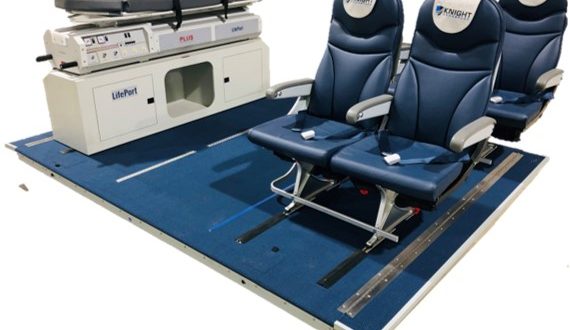For Knight Aerospace, a leader in the design and manufacturing of aeromedical modules and pallets for use in military cargo craft, it’s all about the people.
Whether it’s the patients they’re treating in the air or the crew and staff who are treating them, Knight stands out among aerospace companies for its products that are designed for comfort, protection, and safety.
The medical modules are just one of several product lines crafted to transport people safely and effectively on cargo aircraft.
While the company has been around for 30 years, it’s only recently shifted from its original focus of ground support equipment and simpler palletized solutions to aeromedical modules. The Ebola virus outbreak was a driver to rethink the way patients were transported in military aircraft. As a result, Knight is now unique among aerospace companies in providing safe ways to transport patients, often under dangerous conditions.
Knight Aerospace Rethinks Approach to Mobile Patient Care
Knight Aerospace leaders saw firsthand how people were being transported on military cargo planes and that there was a need for a higher standard of care. Often, patients were loaded onto a stretcher and placed in the back of the aircraft. The stretcher was frequently not secured well and the environment was noisy and unclean.
The company says it began speaking with practitioners, military flight surgeons, pilots, and military experts to develop new approaches that provide for better conditions at all stages of transport missions. Many of those professionals act as advisers to the company today.
Consider that a doctor or flight nurse may be the one strapping a patient into a seating pallet, ensuring it’s loaded correctly, beginning treatment, and starting oxygen and IV fluids or drugs. All that activity happens while a military aircraft navigates takeoffs, landings, turbulence, and the normal flight operations of a plane intended largely for transporting equipment and supplies.
Medical Modules Built for Aerospace
The medical modules Knight Aerospace provides are built with safety in mind. The medical modules are built with a focus on airworthiness, meaning they’re able to withstand rough landing and takeoff conditions and g-forces while providing a safe environment for patients and staff.
The company’s aeromedical bio-containment modules are built with negative air pressure systems, meaning that any infections remain in the patient’s room, without infecting other medical or flight crew.
These specialized modules, now in production, are designed with three different areas — a patient area, an anteroom, and a staff area. As the COVID-19 pandemic continues worldwide, these bio-containment modules are a critical step to keeping infection contained while providing care.
The medical modules can be customized with beds and equipment removed to isolate infected patients from other wounded patients who aren’t carrying an infectious airborne organism.
The medical modules also allow for maximum air exchanges, wall-mounted equipment placement, video monitoring and telehealth, vibration and noise dampening, and the functionality to perform resuscitative care and procedures to address major trauma.
While there are a few other aerospace companies in the medical module space, those systems are generally crude. For example, the modules are repurposed cargo containers that need to be chained into the aircraft. In contrast, the Knight Aerospace module locks into the existing cargo handling system already in place on the aircraft.
The modules roll on and off the plane and are safely and quickly decontaminated upon landing.
The roll-on, roll-off system has multiple advantages. For one, it allows for a plane to run multiple mission types easily. The modules can also be used in different airplane types, including C-130, C-17, A400M, C-5, and C-390.
Customization Is a Key Feature
The palletized systems within the Knight Aerospace product lines provide customers with optimal flexibility. Customers can customize the function, form, and look of the systems to meet specific or multiple transportation needs. This approach sets Knight apart from other aerospace companies.
The pallet design is scalable and comes in 108- and 88-inch widths to accommodate aircraft types. There are no gaps between pallets and anti-movement devices mean no shifting in flight. The company provides galley and lavatory solutions that are Federal Aviation Administration (FAA)-certifiable and built to rigid military standards.
Like the medical modules, the pallets are designed for rapid loading and unloading and plug into aircraft power and communications systems. In addition to functioning on military aircraft, the pallets can operate on commercial cargo planes, including the L100, LM-100J, B737 and B747.
The transportation pallets can be configured for up to 18-seat economy seating, eight-seat business class seating, or club seating with tables, all with standard safety equipment included. Pallets can be designed with lavatories embedded or included in separate galley/lavatory pallets.
With a large aircraft such as a C-130 that comes with four massive turboprop engines, the noise and vibrations can be deafening. The company designs seating pallets to be as comfortable as possible with airplane-quality seating. When transporting high ranking officials or political leaders and other influential passengers, the modules allow for comfort and function.
The pallets can be customized to meet customer needs using standard foundations for most of its pallets and modules. The standardization is helpful to provide economies of scale to address customer needs, whether it’s VIP seating or special operations needs (including drones, missiles, and reconnaissance tech), there is building flexibility.




